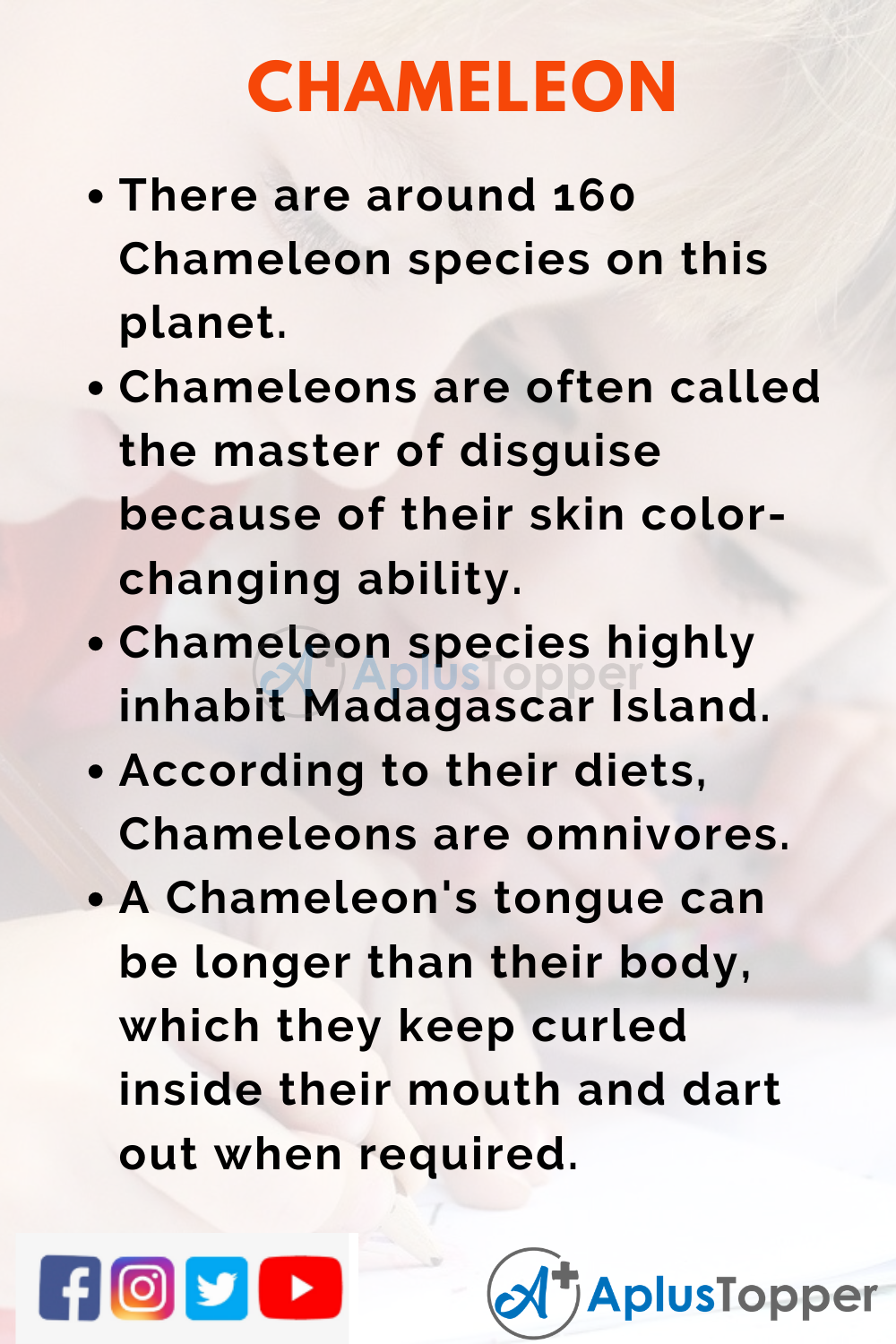10 Lines On Chameleon: A very talented reptile type of animal species is the Chameleon. The scientific name of Chameleon is Chamaeleonidae sp. This lizard species has inhabited warmer places all around the world. Chameleons are characterized by a small or big body with four feet and five toes on each. The Chameleon head consists of two big eyes, which is rotatable. The tail of Chameleons can also be curled, and the skin of chameleons is dry and scaled. Most Chameleon species can change their skin color for camouflage.
You can read more 10 Lines about articles, events, people, sports, technology many more.
Set 1 – 10 Lines On Chameleon for Kids
Set 1 is helpful for students of Classes 1, 2, 3, 4 and 5.
- There are around 160 Chameleon species on this planet.
- Chameleons are often called the master of disguise because of their skin color-changing ability.
- Chameleon species highly inhabit Madagascar Island.
- According to their diets, Chameleons are omnivores.
- A Chameleon’s tongue can be longer than their body, which they keep curled inside their mouth and dart out when required.
- Chameleons use their tongue to catch their prey, which are mostly insects.
- Chameleons can control and move one eye independently at a time.
- The Chameleons’ eyes can move such that they can see in two different directions at the same time.
- Chameleons are also commonly popular to be kept as pets in human households.
- Many species of Chameleons are endangered because of the loss of habitats due to deforestation.

Set 2 – 10 Lines On Chameleon for School Students
Set 2 is helpful for students of Classes 6, 7 and 8.
- The recorded smallest size of a Chameleon is half of an inch.
- The giant Malagasy Chameleon to exist is 27inches long.
- Other than Madagascar, Chameleons can also be found in different regions of Africa, south of Asia, southern Europe, etc.
- The typical habitats for Chameleons are trees, bushes, and ground.
- Chameleons only socialize during mating seasons.
- As a defense, Chameleons’ evolve to have natural skin color as same as their surroundings.
- Chameleons’ diet is dominated by insects like mantids, grasshoppers, locusts, stick-bugs, crickets, etc.
- Chameleons can even be found in deserts because they don’t need much water for survival.
- The color of the skin changes in Chameleons to express its different moods.
- Chameleons can shed their old dry and skin (scales) in small parts.
Set 3 – 10 Lines On Chameleon for Higher Class Students
Set 3 is helpful for students of Classes 9, 10, 11, 12 and Competitive Exams.
- One of the reptiles which are part of the iguana suborder is the Chameleons.
- In response to emotions like stress, anger, fear, etc. Chameleons change their skin color.
- Some species of Chameleons have beautifully decorated heads with skin accessories shaped like horns, crowns, etc.
- The full 360 views of Chameleons allow them to watch at their prey and predator simultaneously in two different directions.
- Chameleons have eyes covered by joined upper and lower eyelids with only a pinhole like opening for the pupil.
- Chameleons can shoot their long elastic tongues to catch insects.
- Madagascar Chameleons have a very short lifespan of only three months.
- Other than Madagascar Chameleons, usually one to two years are taken by chameleons to mature.
- The cells responsible for the color-changing quality of the Chameleon skin are the chromatophores.
- The change in color of the Chameleons’ skin can be for as little as only twenty seconds.

FAQ’s on 10 Lines On Chameleon
Question 1.
Name some of the animals that eat chameleons.
Answer:
Chameleons need to protect themselves from predators like birds, snakes, and even monkeys. Because of their small standard size, Chameleons are more likely to be eaten. Chameleons are also at the bottom of the food chain even after having the camouflaging ability.
Question 2.
How do the chameleons use skin color to express their feelings?
Answer:
On being studied, dominant male Chameleons are observed to have a bright color, which makes them attractive to the female half of the species. The more submissive the Chameleon is the lighter shade of brown or grey they are. The colors of female Chameleons can express a wide range of details, be it for an expression to accept or reject a male chameleon suitor, or indicate their pregnant condition.
Question 3.
How do chameleons change their skin color?
Answer:
Chameleons can change their skin color by adjusting chromatophore cells and also by the controlled release of melanin chemicals. Other studies have also shown that the iridophore cells of each skin layer also contribute to the change of Chameleons’ skin color.
Question 4.
Do chameleons need a lot of water?
Answer:
Water is essential for Chameleon’s growth, but they don’t need a lot of it. Chameleons require regular access to water and preferably look for a dripping water source instead of a puddle.
